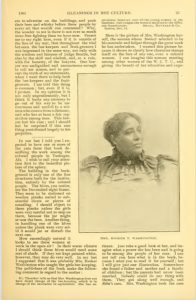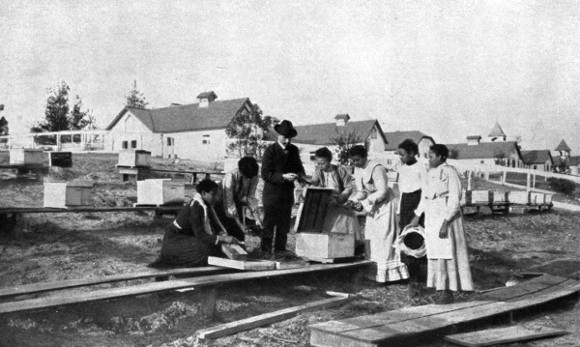Appendix B: Historical References
It is important to recognize that it wasn’t just white male colonizers that innovated beekeeping in North America. There were many people who worked with bees and generated new innovations in beekeeping that were in alignment with natural cycles of the honey bee hive. For example, Charles Henry Turner’s discovery of color and pattern vision in honey bees.
Often the voices of people of color and women are erased from history because they were not in positions of power or did not have networks to get information out to broader networks. Latinx beekeepers have been working with bees since the 1950s, though we don’t have documentation of what was happening before then. Many Indigenous communities harvest honey using pre-Hispanic techniques, such as clay pots. African-American and Indigenous populations in the US were honey hunters, farmers and gardeners as Tammy Horn references in her book, Bees in America: How the Honey Bee Shaped A Nation.
Below are some resources to learn more on the “forgotten” contributors to beekeeping history.
Beekeeping and African-Americans
Annotated bibliography on Beekeeping and African Americans
Charles Henry Turner

Charles Henry Turner and investigations into color vision and pattern vision in honey bees – follow link to download full text PDF for free (another online version is available if your institution has a subscription to Annual Reviews in Entomology.)
Short bibliography on Charles Henry Turner
Booker T. Washington, Margaret Murray Washington, and Black Lady Beekeepers of the Tuskegee Institute, Alabama

A.I. Root tribute to Booker T Washington after his death
A.I. Root writing about Margaret Murray Washington and lady beekeepers
George Washington Carver


Excerpt on George Washington Carver and beekeeping
Beekeeping and Asian Americans

From Gleanings in Bee Culture: article on Chinese American beekeeper Leung Chung
Excerpt from Bees in America referencing above article on Leung Chung
Francis Huber and Marie Lullin


Excerpt on Francis Huber and illustration of bees, including up-close drawings of anatomy, and lots of info on queen bees
Francis Huber’s wife, Marie-Aimee Lullin: “Mdlle. Lullin…During the forty years of their married life, her tenderness and devotion toward her husband were unfailing. She was his reader, his secretary, his observer; he said of her, in his old age: “As long as she lived I was not sensible of the misfortune of being blind.”
Media Attributions
- Charles Henry Turner © Wikimedia Commons is licensed under a Public Domain license
- Booker T. Washington © Wikimedia Commons is licensed under a Public Domain license
- Margaret Murray Washington Gleanings in bee culture 1874 is licensed under a Public Domain license
- Margaret Murray Washington © C. M. Battey is licensed under a Public Domain license
- Margaret Murray Washington Gleanings in bee culture Class of girls learning bee-keeping is licensed under a Public Domain license
- Black women beekeepers is licensed under a Public Domain license
- George Washington Carver c1910 © Wikimedia Commons is licensed under a Public Domain license
- George Washington Carver standing in field © Wikimedia Commons is licensed under a Public Domain license
- Leung Chung is licensed under a Public Domain license
- Francis Huber is licensed under a Public Domain license
- Naturalist’s Library Volume VI. Bees frontispiece is licensed under a Public Domain license






Feedback/Errata